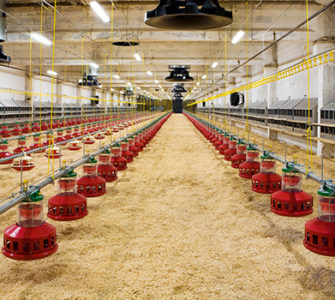The case for built-up litter in US broiler complexes
By John A. Smith, DVM, MS, MAM
Alectryon, LLC
Baldwin, GA
Intuition suggests that cleaning out a poultry house between each flock should be beneficial for bird health and productivity and that built-up, used litter could have adverse health and productivity consequences. These assumptions, however, don’t always hold true for many if not most US broiler complexes where experience tells us that used, built-up litter isn’t necessarily negative. In fact, it may have multiple benefits.
There are multiple reasons why new litter and frequent cleaning out isn’t always helpful. First, consider the typical US broiler-house structure. Most houses have dirt floors. The walls, whether full or partial (as in curtain houses), are generally of porous materials such as unglazed concrete blocks or unfinished plywood, particle board, etc. Ceilings typically are covered with a thin plastic “tri-ply,” which readily develops holes that expose the underlying, absorbent insulation. There are often a thousand cracks and crevices. Sterilizing such an environment is virtually impossible.
Next, consider the fact that in many cases “cleaning out” means removing whatever litter the Bobcat or scrape blade can get. The upshot is that when we perform a routine cleanout of a typical US broiler house, we’re probably having only a modest impact on the pathogen load. A shovel full of litter left in a poultry house is probably enough to infect the next flock with many of the more resistant disease agents like infectious bursal disease (IBD) or chicken anemia virus.
Finally, many pathogens, including coccidial oocysts, deteriorate fairly rapidly given proper downtime and temperature, normalizing the residual load after each growout. The added burden of three or six growouts might not be biologically significant compared to the constant background level of pathogens. Under these circumstances, cleaning out isn’t really that beneficial and, in comparison, reusing litter isn’t really that different from a typical superficial cleanout.
Draconian cleanouts
I don’t mean to imply that a periodic cleaning out isn’t necessary or that cleaning and disinfection shouldn’t be attempted to solve a disease problem that might arise.It does mean that for cleaning out to have a significant impact on disease containment, it must be draconian.
All litter must be removed. Ideally that should be followed by use of a highway-type sweeper on the bare floors. Everything in the house — ceiling, walls, curtains, louvers, inlets, fans, drinkers, feeders and all other fixtures — need to be washed thoroughly first, then dried and carefully disinfected. Large volumes of a very strong, preferably caustic disinfectant such as a mineral acid or even a burner should be used on dirt floors.
How many producers go to this extent and, if not every time, how often? Producers who aren’t going to this extreme regularly probably aren’t doing much more to control disease than those using built-up litter interspersed with periodic, serious cleanouts.
The EU experience
Let’s consider the situation in Europe because it’s instructive. Poultry houses in Western Europe have cement floors and impervious walls. They’re cleaned and disinfected between each flock.
Despite this effort, a virulent form of IBD was a serious problem in Europe in the 1990s. Necrotic enteritis and clostridial dysbacteriosis remain significant problems.
Again, this observation isn’t meant to be critical of Europe’s husbandry style, but it serves to point out that routine, complete cleanout and disinfection of houses with impervious surfaces doesn’t solve all disease problems.
New-house syndrome
So-called “new-house syndrome” is familiar to most experienced poultry producers. Some of the worst cases of coccidiosis and necrotic enteritis can be seen in brand-new houses or on new litter.
The development of new-house syndrome has to do with the fact that coccidia are ubiquitous and every flock gets exposed. With built-up litter, chicks are exposed immediately. They have a smaller GI capacity compared to older chicks, and the coccidial challenge is gradual and occurs when the effects of coccidia are less deleterious. They develop immunity in pace with the increasing challenge.
In a new house, or one with a cement floor that’s thoroughly cleaned before each flock, exposure may be delayed until the organism is tracked in, which is almost guaranteed, or the small residual load is eventually replicated by the new flock. By now the birds are larger and older. They replicate the parasite more rapidly because they can ingest more oocysts faster and have a larger gut. The challenge builds more rapidly than their immunity develops, and the result is disease.
Old farms, good results
Many of us in the poultry industry have encountered older farms that may not have the latest equipment but where a skilled manager will consistently outperform the average. Contrast that to a newer farm with up-to-date equipment and an equally competent and industrious manager who consistently struggles to perform and has consistent, ill-defined disease problems.
It would appear that some farms, for reasons unknown to us, simply develop a favorable microbial ecology in the houses, and some do not. There may be a competitive-exclusion phenomenon in operation on a whole-house or farm basis. My point here is that if things are going well, there’s no compelling reason to clean out. “If it ain’t broke, don’t fix it.” On the problem farm, the draconian cleanout and disinfection is one rational way to try and solve the problem.
Brooding benefits
Since built-up litter generates considerable heat, properly managed built-up litter can also assist in brooding. Careful caking out (housekeepers work great), top-dressing with a thin layer of clean shavings and use of an ammonia-control amendment provide a very suitable surface for brooding.
A thick bed of new litter might insulate chicks against the cold ground, but it won’t generate as much heat as used litter. Heat generation is obviously not a benefit later on during the growout in hot weather, but with modern ventilation, this hasn’t been a major problem.
Timing cleanouts
The industry norm seems to be for one or two annual cleanouts, although some do so far less often. At some point, however, the threshold could be exceeded and/or the competitive-exclusion system could break down and drastic action is needed, particularly if downtime is insufficient. The trick is to perform a cleanout and knock down the pathogen load before that critical mass is reached.
Clearly, effective cleaning and disinfection of houses with impervious floors, walls and ceilings may be necessary for complete control of Salmonella and Campylobacter, and current US-style housing and cleanout practices will be problematic for control of these pathogens. It’s unknown but doubtful whether the typical non-draconian cleanout in this style house has a measureable impact on Salmonella loads in subsequent flocks compared to used litter, and research is needed in this area.
Ammonia control
The primary issue with used litter is ammonia control. Modern stage controllers and litter amendments enable better air-quality control so the benefits of built-up litter can be realized.
Furthermore, thin, new litter doesn’t necessarily protect against ammonia buildup. If the layer of litter is thin, the dirt itself can become a potent ammonia source.
Additional benefits
A thicker, used litter pack is much more absorbent than new litter. With proper diets, coccidiosis control, and drinker and ventilation management, deep litter can be kept very dry, and it’s more forgiving than new litter if there’s a temporary error or problem in moisture management, such as a ventilation error, leaking drinkers or an episode of flushing.
There appears to be a higher incidence of ascarids when houses are cleaned out for every flock and rebedded with a thin layer of new litter. In contrast, ascarid problems appear to be rare in short-lived broilers on deep, used litter. Coccidiosis control, disease incidence and carcass quality, including paws, don’t appear to suffer from properly managed built-up litter.
Finally, the economic and environmental advantages of built-up litter are obvious. A deeper bed of litter can be maintained year-round, for less money. It requires less labor, equipment and fuel than would be used to clean out; less wear and tear on the housing and equipment than occurs with repeated cleanouts; less demand on forest products for bedding; and less litter to dispose.
In summary, a thorough cleanout, including radical washing and disinfection, followed by installation of a thick bed of new litter, would likely be the optimum management style in houses with impervious floors and surfaces, but for most US broiler complexes, it’s just not feasible. Considering the construction, materials and management of most US broiler houses, the built-up litter system appears to be not only as good as but is possibly superior to routine replacement of litter between each flock.
Editor’s note: The opinions and advice presented in this article belong to the author and, as such, are presented here as points of view, not specific recommendations by Poultry Health Today.
Posted on February 18, 2018

















